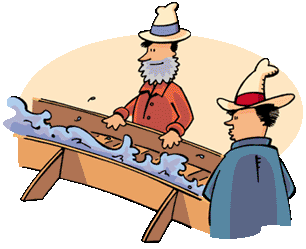There's Gold in Them Thar Hills! The Butte Boom
Updated: August 4, 2020

Let's go back a few years. Butte City, in the Silver Bow Creek valley, really began as silver camp. Gold had been discovered around 1864 but miners ran into so much silver that the gold was tough to recover. Gold mining in the area didn't look profitable and it wasn't particularly rich in ore anyway. In 1866 Butte city was still a small camp with a couple of hundred miners, a few saloons and no general store. A.J. Davis acquired a group of mines and a small quartz mill for $20.00 plus his white horse in 1868. Davis expanded the stamp mill and began concentrating his efforts on silver. But Davis couldn't turn a profit on silver mining and so he lost his holdings to the bank. Ironically, A. J. Davis did go on to a lucrative career in banking, founding the First National Bank and becoming Montana's first millionaire. A man by the name of Dexter acquired the Davis holdings and became the first to successfully mine silver in the area. Thus begins Butte's silver era. This boom brought many people into the camp. Still, Butte City would not become famous for its silver deposits.
Until the late 1880's, copper was used only for pots and pans, roofing material, and maybe some ornamental decoration. When the electrical industry spread, so did demand for copper. Every industrialized city in the world was installing streetlights. People wanted electricity in their homes. Obviously, the uses for electricity are endless. Just take a look around you. In 1882 Marcus Daly, who'd been in the mining industry for years, came across a deposit of copper in the silver-mining camp at Butte City, Montana (now shortened to Butte). Daly discovered that the ore found in a large hill (Butte Hill) outside of Butte contained up to 35 percent copper. Today that hill is called "The Richest Hill on Earth." This is no exaggeration. Before long, by 1898, Butte would supply 41 percent of the world's copper- more than any other site in the world.

Marcus Daly certainly had plans for Butte. He convinced investors to construct a new city near Butte, named Anaconda. This is where the ore was to be smelted. Smelting is a process of heating ore in order to extract precious metals. Men were brought in from all around the world -- Wales, Finland, Ireland, China; the list goes on -- to work in these emerging cities. These ethnic groups tended to form small communities within each city, like Walkerville and Dublin Gulch in Butte. A railway way was built to carry copper ore from Butte to Anaconda, about thirty miles away. Daly and his associates erected the largest smelter of its time. By 1898 copper was bringing in over one million dollars per year.
Butte incorporated in 1879, dropping the (city) part of its name at that point. Butte had become a city complete with police and fire departments, three daily papers, 28 schools, 225 active mines, a library and more saloons than you could count. 65,000 people were living in Butte. Thirteen thousand of them were miners or smelters. In nearby Helena during this time lived more millionaires per capita than in any other city in the United States. In fact, there was a club known as the Montana Club. Unless you were a millionaire, you couldn't join. You can be sure that club had plenty of members.
Butte must have been a wild and magnificent place during those years. It was at the center of much of the world’s economy. Huge ornate mansions were constructed. During election campaigns the entire city would shut down and go on a binge, taking in the free whiskey and dollar bills left lying in barrels by wealthy businessmen. This is how business leaders bought their votes. They also owned most of the newspapers in Montana. Butte continued to boom until the mid 1920s when the price of copper crashed. As a boomtown, Butte was bound to bust. The lifestyle couldn't last. The world economy changed. Other mines began competing with the Anaconda Company to supply the world's copper. And later, people would find significant problems with mines and the mining industry.
Updated: August 4, 2020

